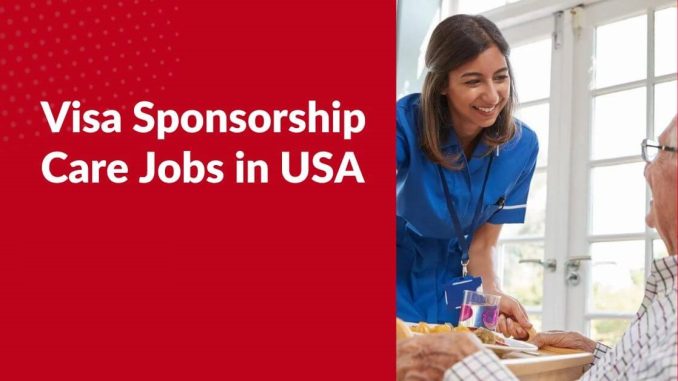
The United States has a growing demand for caregivers, and if you’re looking to pursue this rewarding profession, visa sponsorship can be your gateway to starting a career in the U.S. As an international worker, finding a job in the caregiving field with visa sponsorship might seem daunting, but there are plenty of opportunities available, especially as the U.S. faces an aging population in need of healthcare and assistance.
In this blog post, we’ll explore caregiver jobs in the U.S. that offer visa sponsorship, the types of visas available, and how you can navigate the process of applying for caregiving positions in the United States.
Caregiver Jobs with Visa Sponsorship in the USA
What Are Caregiver Jobs?
Caregivers, often referred to as home health aides or personal care aides, provide essential services to individuals who need assistance with daily activities due to age, illness, or disability. The roles can range from basic companionship and help with tasks like eating and bathing to more specialized healthcare assistance for patients with chronic conditions.
Caregiver jobs are available in various settings, such as private homes, healthcare facilities, nursing homes, or hospitals. The key responsibilities typically include:
- Assisting with daily activities (bathing, eating, dressing)
- Administering medication under supervision
- Providing companionship
- Assisting with mobility and physical therapy exercises
- Monitoring health and well-being
Visa Sponsorship for Caregiver Jobs
In the U.S., many caregiving positions do not require specialized degrees but often demand compassion, patience, and the ability to perform physical tasks. For international workers, the idea of securing a caregiving job that offers visa sponsorship can be a valuable opportunity.
There are a few visa types that can be used for working in caregiver roles in the U.S.:
1. H-2B Visa (Temporary Non-Agricultural Workers)
The H-2B visa is often used for seasonal or temporary jobs, which includes caregiver positions in specific settings like nursing homes or healthcare agencies. This visa is typically issued for short-term employment and is often tied to specific job offers. H-2B visa holders can work in the U.S. for up to one year, with the possibility of extending it for an additional year.
2. B-1 Visa (Domestic Employees)
The B-1 visa allows caregivers to come to the U.S. as domestic employees, usually for individuals who need in-home care. For example, if you are hired to assist an American family with caregiving needs, this visa may be an option. However, B-1 visa holders cannot apply for permanent residency or work for other employers under this visa.
3. EB-3 Visa (Employment-Based Immigrant Visa)
The EB-3 visa is a more permanent solution for caregivers who plan to stay in the U.S. long-term. The EB-3 visa is for skilled workers, professionals, and other workers, and caregivers can qualify as “other workers” if their job involves non-skilled labor. This visa is ideal for caregivers seeking long-term employment in the U.S. and a pathway to permanent residency.
4. J-1 Visa (Exchange Visitor Program)
The J-1 visa is designed for individuals who participate in an exchange program, such as cultural exchange or training. Some caregiving positions in specific healthcare settings offer J-1 visa sponsorship, especially for those looking to gain training and experience in healthcare.
Finding Caregiver Jobs with Visa Sponsorship
The first step in finding a caregiving job with visa sponsorship is to search for U.S.-based caregiving agencies, nursing homes, or healthcare providers that hire international workers. Many employers that offer visa sponsorships will be looking for candidates with some caregiving experience, either in a formal or informal capacity.
You can search for jobs through job boards like:
- Indeed
- Glassdoor
- Care.com
Additionally, you can reach out directly to healthcare agencies and nursing homes to inquire about open positions and visa sponsorship opportunities.
Frequently Asked Questions (FAQs)
1. Can I get a caregiver job in the U.S. without a visa?
For most international applicants, obtaining a job in the U.S. requires visa sponsorship. There are some limited exceptions, such as if you already have a visa that allows you to work, but generally, you’ll need sponsorship from your employer. This could be through H-2B, B-1, or EB-3 visas, depending on the type of caregiving work you’re applying for.
2. How long does it take to get a caregiver visa for the U.S.?
The processing time for a caregiver visa can vary depending on the type of visa you’re applying for and the workload of U.S. immigration authorities. For example, the H-2B visa can take several months to process, while the EB-3 visa for permanent residency could take up to a year or longer. It’s essential to plan ahead and allow enough time for processing and potential delays.
3. What qualifications do I need to apply for caregiver jobs in the U.S.?
In the U.S., there are no strict educational requirements for caregiver jobs, but many employers prefer candidates with some relevant experience or certifications. While a high school diploma is often enough, having training in home health care, CPR certification, or experience as a caregiver can make you a more competitive candidate. Some agencies may also require a background check and health screening.
Conclusion:
Caregiver jobs with visa sponsorship in the U.S. offer a fulfilling career opportunity for individuals who are compassionate and dedicated to helping others. By understanding the visa options available, such as the H-2B, EB-3, and B-1 visas, you can pave the way to a career that not only supports others but also allows you to experience life in the U.S.
While the process may take some time and effort, there is a significant demand for caregivers in the U.S., making it possible for international workers to secure jobs with visa sponsorship. As you look for caregiver positions, be sure to keep an eye on job boards and reach out to U.S.-based employers who offer visa sponsorship. With patience and determination, you’ll be well on your way to starting your caregiving career in the U.S. in 2025!
Leave a Reply